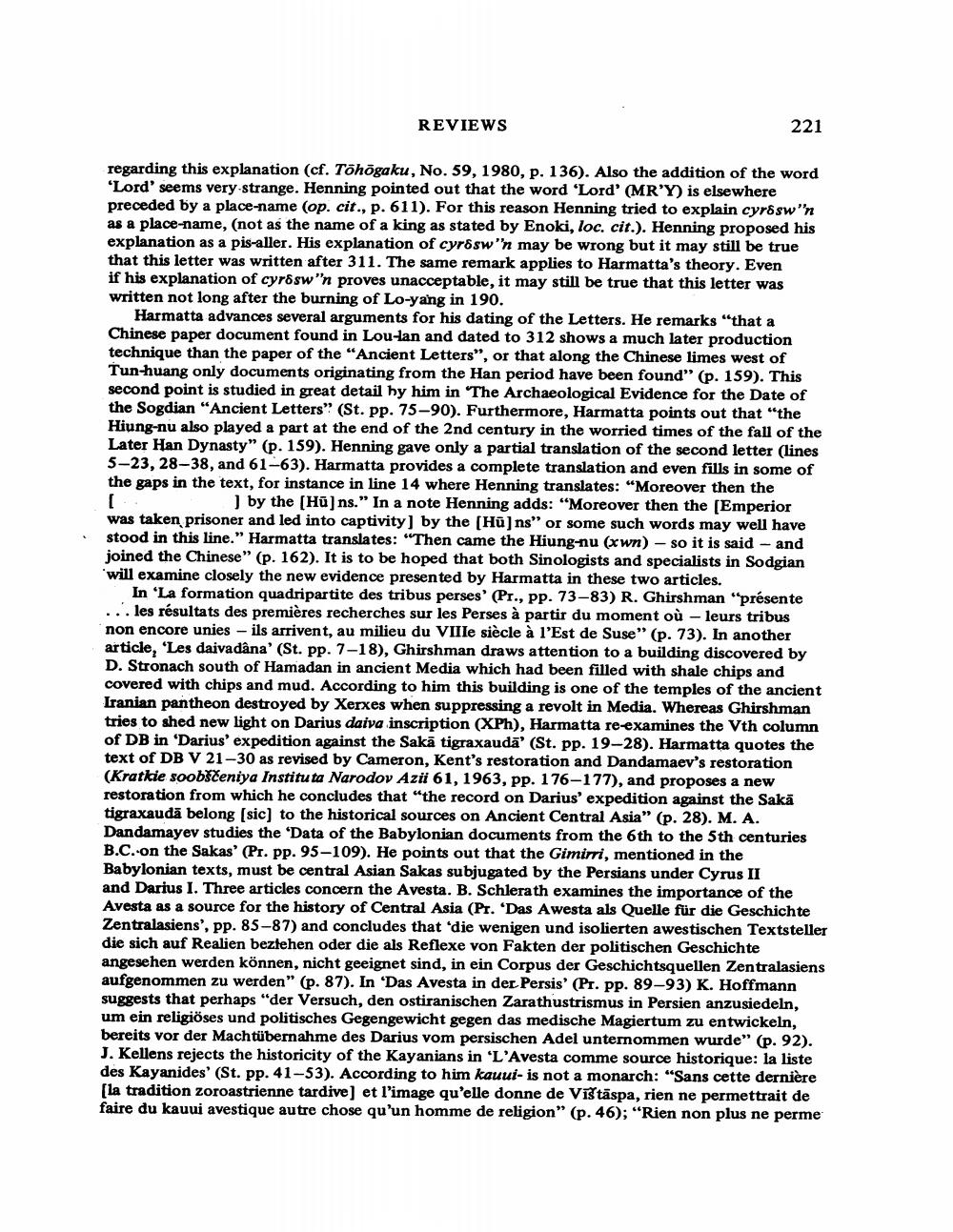________________
REVIEWS
221
regarding this explanation (cf. Töhögaku, No. 59, 1980, p. 136). Also the addition of the word 'Lord' seems very strange. Henning pointed out that the word 'Lord' (MR'Y) is elsewhere preceded by a place-name (op. cit., p. 611). For this reason Henning tried to explain cyr sw'n as a place-name, (not as the name of a king as stated by Enoki, loc. cit.). Henning proposed his explanation as a pis-aller. His explanation of cyrosw'n may be wrong but it may still be true that this letter was written after 311. The same remark applies to Harmatta's theory. Even if his explanation of cyrosw'n proves unacceptable, it may still be true that this letter was written not long after the burning of Lo-yang in 190.
Harmatta advances several arguments for his dating of the Letters. He remarks "that a Chinese paper document found in Lou-lan and dated to 312 shows a much later production technique than the paper of the "Ancient Letters", or that along the Chinese limes west of Tun-huang only documents originating from the Han period have been found” (p. 159). This second point is studied in great detail hy him in "The Archaeological Evidence for the Date of the Sogdian "Ancient Letters" (St. pp. 75-90). Furthermore, Harmatta points out that "the Hiung-nu also played a part at the end of the 2nd century in the worried times of the fall of the Later Han Dynasty" (p. 159). Henning gave only a partial translation of the second letter (lines 5-23, 28-38, and 61-63). Harmatta provides a complete translation and even fills in some of the gaps in the text, for instance in line 14 where Henning translates: "Moreover then the
I by the (Hü] ns." In a note Henning adds: “Moreover then the (Emperior was taken prisoner and led into captivity] by the (Hū]ns" or some such words may well have stood in this line." Harmatta translates: "Then came the Hiung-nu (xwn) - so it is said - and joined the Chinese" (p. 162). It is to be hoped that both Sinologists and specialists in Sodgian 'will examine closely the new evidence presented by Harmatta in these two articles.
In 'La formation quadripartite des tribus perses' (Pr., pp. 73-83) R. Ghirshman "présente ... les résultats des premières recherches sur les Perses à partir du moment où leurs tribus non encore unies - ils arrivent, au milieu du VIIIe siècle à l'Est de Suse" (p. 73). In another article, 'Les daivadâna' (St. pp. 7-18), Ghirshman draws attention to a building discovered by D. Stronach south of Hamadan in ancient Media which had been filled with shale chips and covered with chips and mud. According to him this building is one of the temples of the ancient Iranian pantheon destroyed by Xerxes when suppressing a revolt in Media. Whereas Ghirshman tries to shed new light on Darius daiva inscription (XPh), Harmatta re-examines the Vth column of DB in 'Darius' expedition against the Sakā tigraxaudā' (St. pp. 19-28). Harmatta quotes the text of DB V 21-30 as revised by Cameron, Kent's restoration and Dandamaev's restoration (Kratkie soobščeniya Instituta Narodov Azü 61, 1963, pp. 176-177), and proposes a new restoration from which he concludes that "the record on Darius' expedition against the Sakā tigraxaudā belong (sic) to the historical sources on Ancient Central Asia" (p. 28). M. A. Dandamayev studies the 'Data of the Babylonian documents from the 6th to the 5th centuries B.C. on the Sakas' (Pr. pp. 95-109). He points out that the Gimirri, mentioned in the Babylonian texts, must be central Asian Sakas subjugated by the Persians under Cyrus II and Darius I. Three articles concern the Avesta. B. Schlerath examines the importance of the Avesta as a source for the history of Central Asia (PT. 'Das Awesta als Quelle für die Geschichte Zentralasiens', pp. 85-87) and concludes that 'die wenigen und isolierten awestischen Textsteller die sich auf Realien beztehen oder die als Reflexe von Fakten der politischen Geschichte angesehen werden können, nicht geeignet sind, in ein Corpus der Geschichtsquellen Zentralasiens aufgenommen zu werden" (p. 87). In 'Das Avesta in der Persis' (Pr. pp. 89-93) K. Hoffmann suggests that perhaps "der Versuch, den ostiranischen Zarathustrismus in Persien anzusiedeln, um ein religiöses und politisches Gegengewicht gegen das medische Magiertum zu entwickeln, bereits vor der Machtübernahme des Darius vom persischen Adel unternommen wurde” (p. 92). J. Kellens rejects the historicity of the Kayanians in 'L'Avesta comme source historique: la liste des Kayanides' (St. pp. 41-53). According to him kauui- is not a monarch: "Sans cette dernière [la tradition zoroastrienne tardive] et l'image qu'elle donne de Vištāspa, rien ne permettrait de faire du kauui avestique autre chose qu'un homme de religion" (p. 46); "Rien non plus ne perme




